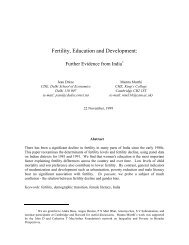You also want an ePaper? Increase the reach of your titles
YUMPU automatically turns print PDFs into web optimized ePapers that Google loves.
eligious school known as Shaivism (from the god of creativity and destruction,<br />
Shiva) had preached that the world was unreal and an impersonal abstract essence<br />
was the absolute reality and truth. <strong>The</strong> Jain and Buddhist religions, which had sprung<br />
from Hinduism, also preached privation, renunciation and destruction of the self.<br />
Vallabhacharya saw a personal god who created and sustained life, for whom living<br />
life to the full was a form of devotion. His school became known as Vaishnavism, as<br />
the focus of devotion was the god Vishnu’s playful avatar (incarnation) Krishna, perhaps<br />
the most widely adored and human face of the divine among Hindus.<br />
In his classic text on the Vaishnavas of Gujarat, the scholar N. A. Thoothi pointed out<br />
that this naturally appealed to the people of a land richly endowed with opportunity<br />
like the central parts of Gujarat. It was a philosophy that justified their way of life<br />
and gave a divine purpose to their roles as providers and family members. It also<br />
fitted the rising social status of the Banias in Gujarat, overriding the formal varna<br />
hierarchy.<br />
As Vaishnavism grows, the Varnas decline. We have noticed, for example, how the<br />
Vanias [Banias] have reached a social status as high as that of the Brahmins<br />
themselves. This upsetting of the balance of the Varnas has been greatly due to<br />
economic causes. <strong>The</strong> merchant and the financier and the capitalist have, by sheer<br />
force of wealth and power, for a while become dictators over all, even over the<br />
priestly class. A justification of their way of living, a theory of life and a pathway<br />
suited and helpful to the living of a life engrossed in work and duty as a man,<br />
husband, father, citizen and so on, a hope that such a mode of life as they live is<br />
acceptable to the highest deity - the Gujaratis naturally sought for all these.<br />
Ambani’s particular caste is called the Modh Bania, from their original home in the<br />
town of Modasa north of Ahmedabad before a migration many centuries ago to<br />
Saurashstra. <strong>The</strong> Modh are one of three Bania castes in this part of Gujarat, who<br />
might eat meals together but who would each marry within their own caste. <strong>The</strong>y are<br />
strict vegetarians, and only the men take alcohol. <strong>The</strong>ir practice of Hinduism follows<br />
the Vaishnavite path. But the main object of their pilgrimages, on marriage or the<br />
start of a new business venture, is a black-faced idol with a diamond in his chin<br />
located in a temple at Nathdwara, a small town in the barren hills behind the lake<br />
city of Udaipur in Rajasthan. This idol represents Srinath, an avatar or incarnation of<br />
Lord Krishna, and was brought to Nathdwara from Mathura (Krishna’s birthplace) by<br />
a holy man to escape the depredations of the fierce anti-Hindu Mughal emperor<br />
Aurangzeb. For reasons that are not clear, Srinath has become the familiar god of<br />
the Modh and other Banias. Portraits based on the Nathdwara idol are often seen in<br />
the offices of Bania businessmen.<br />
In later years, Ambani and his family made frequent visits to the temple of Srinath,<br />
flying into Udaipur airport in his company’s executive jet and driving straight up to<br />
Nathdwara. In 1994, Ambani built a large ashram (pilgrim’s rest-house) in<br />
Nathdwara for the use of visitors. <strong>The</strong> three-storey building, faced in a pink granite,<br />
is dedicated to the memory of his parents.<br />
If the Modh Bania practise piety in the temple, and abstemious ways in their homes<br />
they are known as fiercely competitive and canny traders in the marketplace, with no<br />
communications about taking advantage of opportunities for profit. A saying in<br />
Gujarat goes: ‘apale hojo kadh, pan angane na hojo Modh’s meaning: ‘It is better to<br />
have a leucoderma [a disfiguring skin pigment disorder] on your forehead than a<br />
Modh as guest in your house.’ Like other Bania castes of the region, the Modh Bania




